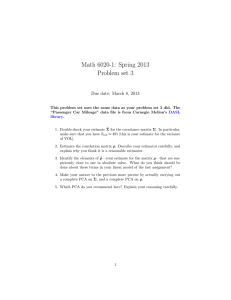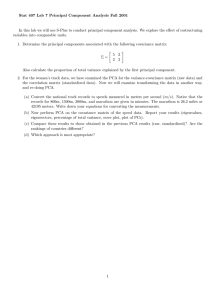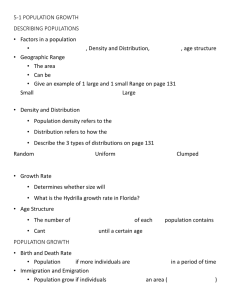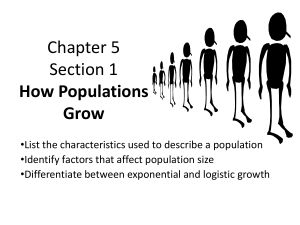Dimensionality Reduction with Generalized Linear Models
advertisement
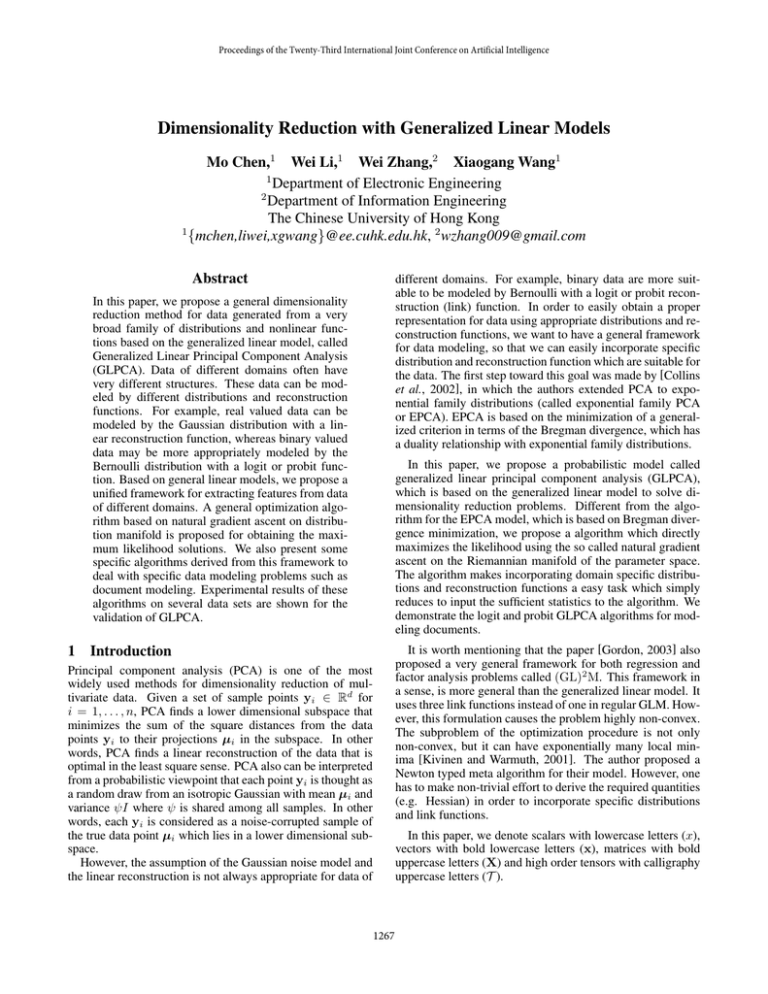
Proceedings of the Twenty-Third International Joint Conference on Artificial Intelligence
Dimensionality Reduction with Generalized Linear Models
Mo Chen,1 Wei Li,1 Wei Zhang,2 Xiaogang Wang1
1
Department of Electronic Engineering
2
Department of Information Engineering
The Chinese University of Hong Kong
1
{mchen,liwei,xgwang}@ee.cuhk.edu.hk, 2 wzhang009@gmail.com
Abstract
different domains. For example, binary data are more suitable to be modeled by Bernoulli with a logit or probit reconstruction (link) function. In order to easily obtain a proper
representation for data using appropriate distributions and reconstruction functions, we want to have a general framework
for data modeling, so that we can easily incorporate specific
distribution and reconstruction function which are suitable for
the data. The first step toward this goal was made by [Collins
et al., 2002], in which the authors extended PCA to exponential family distributions (called exponential family PCA
or EPCA). EPCA is based on the minimization of a generalized criterion in terms of the Bregman divergence, which has
a duality relationship with exponential family distributions.
In this paper, we propose a general dimensionality
reduction method for data generated from a very
broad family of distributions and nonlinear functions based on the generalized linear model, called
Generalized Linear Principal Component Analysis
(GLPCA). Data of different domains often have
very different structures. These data can be modeled by different distributions and reconstruction
functions. For example, real valued data can be
modeled by the Gaussian distribution with a linear reconstruction function, whereas binary valued
data may be more appropriately modeled by the
Bernoulli distribution with a logit or probit function. Based on general linear models, we propose a
unified framework for extracting features from data
of different domains. A general optimization algorithm based on natural gradient ascent on distribution manifold is proposed for obtaining the maximum likelihood solutions. We also present some
specific algorithms derived from this framework to
deal with specific data modeling problems such as
document modeling. Experimental results of these
algorithms on several data sets are shown for the
validation of GLPCA.
1
In this paper, we propose a probabilistic model called
generalized linear principal component analysis (GLPCA),
which is based on the generalized linear model to solve dimensionality reduction problems. Different from the algorithm for the EPCA model, which is based on Bregman divergence minimization, we propose a algorithm which directly
maximizes the likelihood using the so called natural gradient
ascent on the Riemannian manifold of the parameter space.
The algorithm makes incorporating domain specific distributions and reconstruction functions a easy task which simply
reduces to input the sufficient statistics to the algorithm. We
demonstrate the logit and probit GLPCA algorithms for modeling documents.
It is worth mentioning that the paper [Gordon, 2003] also
proposed a very general framework for both regression and
factor analysis problems called (GL)2 M. This framework in
a sense, is more general than the generalized linear model. It
uses three link functions instead of one in regular GLM. However, this formulation causes the problem highly non-convex.
The subproblem of the optimization procedure is not only
non-convex, but it can have exponentially many local minima [Kivinen and Warmuth, 2001]. The author proposed a
Newton typed meta algorithm for their model. However, one
has to make non-trivial effort to derive the required quantities
(e.g. Hessian) in order to incorporate specific distributions
and link functions.
Introduction
Principal component analysis (PCA) is one of the most
widely used methods for dimensionality reduction of multivariate data. Given a set of sample points yi ∈ Rd for
i = 1, . . . , n, PCA finds a lower dimensional subspace that
minimizes the sum of the square distances from the data
points yi to their projections µi in the subspace. In other
words, PCA finds a linear reconstruction of the data that is
optimal in the least square sense. PCA also can be interpreted
from a probabilistic viewpoint that each point yi is thought as
a random draw from an isotropic Gaussian with mean µi and
variance ψI where ψ is shared among all samples. In other
words, each yi is considered as a noise-corrupted sample of
the true data point µi which lies in a lower dimensional subspace.
However, the assumption of the Gaussian noise model and
the linear reconstruction is not always appropriate for data of
In this paper, we denote scalars with lowercase letters (x),
vectors with bold lowercase letters (x), matrices with bold
uppercase letters (X) and high order tensors with calligraphy
uppercase letters (T ).
1267
2
Generalized Linear Principal Component
Analysis Model
For convenience, we denote
g(θ) =∇A(θ),
The classical PCA is a linear model which assumes that an
observation yi is generated from a linear transformation of
a latent low dimensional vector xi plus a bias term m and a
Gaussian noise term ,
yi = WT xi + m + .
(1)
The least square estimator is adapted to this assumption.
However, the restriction of linearity is too strict for a variety
of practical situations. For example, the linear model fails,
when dealing with binary data (Bernoulli) or with count data
(Poisson).
The generalized linear model (GLM) [Nelder and Wedderburn, 1972] was proposed to relax the assumption to a broad
family of nonlinear models for regression problems. In [Rish
et al., 2008], the authors utilized the GLM for supervised dimensionality reduction problems. In this paper, we propose
the GLPCA model to extend PCA with GLM for dimensionality reduction problems. The essential feature of GLPCA is
that the observation yi is a sample from certain distribution
p(y). The expectation µi = E[yi ] is a monotonic function of
ηi such that
E[yi ] = f (ηi ), ηi = WT xi + m.
(2)
Here, we overload the notation f (η) as a vector function that
each elements is obtained by applying f over each elements
of vector η. The conditional distribution p(y|W, x, m) is
a distribution of natural exponential family, which will be
discussed later. The reconstruction function f is also called
the link function in GLM literature. Given the i.i.d. samples {yi } ∈ Rd , our goal is to find the optimal W ∈ Rd×q ,
m ∈ Rd , and {xi } ∈ Rq in the sense that the likelihood of
this model is maximized.
2.1
Σ(µ) =∇∇T A(θ).
(5)
We can see that the expectation of y only depends on the
natural parameter θ whereas the variance of y depends on
both θ and the parameter ψ. Typically one assumes that the
factor ψ is identical over all observations. One example is the
isotropic Gaussian distribution which can be written in the
standard form as
1
ky − µk2
p(y|θ, ψ) =
,
exp
−
2σ 2
(2πσ 2 )d/2
T
(6)
y θ − θ T θ/2 1 yT y
= exp
−
+ ln(2πψ)
,
ψ
2
ψ
where θ = µ,ψ = σ 2 ,A(θ) = θ T θ/2, g(µ) = µ, Σ = I,
and C(y, ψ) = −(yT y/ψ + ln(2πψ))/2),
If the degree of freedom of y is d, then the representation is said to be minimal; otherwise it is over-complete. If
the representation is minimal, the multivariate density can be
factorized as
p(y|θ) =
d
Y
p(yj |θj ).
(7)
j=1
Pd
Then it can be easily verified that A(θ) = j=1 A(θj ) where
we overload the notation A(θj ) to be the partition function of
the univariate distribution p(yj |θj ). As a result, the covariance matrix Σ becomes a diagonal matrix with diagonal elements are Σjj = ψA00 (θj ). This is the case for the isotropic
Gaussian. For convenience, we define
ν(µ) = A00 (θ).
(8)
For a over-complete representation, the degree of freedom
of y is smaller than d. For example, if the sample vector repPd
resents a discrete distribution, i.e., j=1 yj = 1 and yj > 0,
it is natural to model the data by the Dirichlet distribution.
However, if we write the Dirichlet distribution in the form of
natural exponential family (3), the representation is not minimal. Another example is that if the samples are normalized
such that kyk2 = 1, it is natural to model the data by the
von Mises-Fisher distribution, of which the representation in
the form of (3) again is not minimal. For certain distributions, transforming from the over-complete representations
to the minimal ones is non-trivial. The previous EPCA algorithm is based on minimizing the Bregman divergence, and
has an one-to-one map to the natural exponential family with
the minimal representation [Wainwright and Jordan, 2008].
Therefore, EPCA only works with the natural exponential
family with minimal representation. On the other hand, our
GLPCA does not have this restriction. It works with both
minimal and over-complete representations.
Exponential Family
We first introduce the natural exponential family, from which
we derive our GLPCA model. Some quantities of the natural
exponential family are derived and will be used latter in the
algorithm.
In the GLPCA model, we assume that the distribution of
the observation yi is a member of the multivariate natural
exponential family [Wainwright and Jordan, 2008]. The natural exponential family is a class of probability distributions
where the first order statistics are of primary interest. It covers a broad range of distributions, such as Gaussian, Gamma,
Bernoulli and Poisson distributions. The density functions
of the natural exponential family distributions have a general
form
T
y θ − A(θ)
p(y|θ, ψ) = exp
+ C(y, ψ) .
(3)
ψ
y is a d dimensional observation. θ is the natural parameter.
ψ is a scalar dispersion parameter and is a scale parameter of
the variance. A(θ) is called the partition function which plays
an important role in our latter derivation. The expectation and
covariance of y are
E[y] =∇A(θ)
(4)
Cov[y] =ψ∇∇T A(θ).
2.2
Link Function
Apart from the distribution of y, the link function is another
important part of GLPCA. From previous section, we have
µ = f (η) = ∇A(θ)
1268
(9)
where ∇`(θ) is the conventional gradient
T
∂
∂
∇`(θ) =
(14)
`(θ), . . . ,
`(θ) .
∂θ1
∂θd
˜
∇`(θ)
is called natural gradient of ` in the Riemannian manifold [Amari, 1998]. When the manifold is Euclidean space
˜
and the coordinate system is orthonormal, we have ∇`(θ)
=
∇`(θ). This argument suggests the natural gradient ascent
algorithm of the form
˜
θt+1 = θt + τ ∇`(θ
(15)
t ),
In the case that θ(η) = η, i.e., f = ∇A, the function f
is called canonical link. For models with a canonical link,
some theoretical and practical problems are easier to solve.
If a canonical link is used and the data are modeled by the
natural exponential family with the minimal representation,
GLPCA is equivalent to EPCA [Collins et al., 2002] (see
Section 4). Table 1 summarizes the characteristics for some
exponential family distributions together with natural parameters and canonical link functions. GLPCA also can work
with non-canonical link functions. For a specific distribution,
a family of special link functions is valid. For example, the
(canonical) logit link and cumulative Gaussian link can both
be used with the Bernoulli distribution, called logistic and
probit model respectively. A very flexible class of link functions is the class of power functions which are also called the
Box-Cox transformations [Box and Cox, 1964]. They can be
defined for all models for which we have observations with
positive means. This family is usually specified as
µλ
if λ 6= 0;
η=
(10)
ln µ if λ = 0.
where τ is the learning rate that determines the step size.
Since the Riemannian manifold is invariant under transformation of coordinate θ and random variable y, the natural
gradient ascent algorithm is also invariant under the transformation. The natural gradient method has been successfully
applied on various machine learning models, including neural network and ICA [Amari and Nagaoka, 2000].
3.2
Maximizing Likelihood of GLPCA
For GLPCA model, the log-likelihood of the observations is
n
X
L=
`(yi ; θi )
We summarize some commonly used link functions in Table 2
i=1
3
Maximum Likelihood Estimation
=
In this section, we present the algorithm for maximum likelihood estimation based on the natural gradient ascent in the
Riemannian manifold of distributions.
3.1
ψ
(16)
+ C(yi , ψ) ,
where
θi = θ(ηi ) = θ(WT xi + m).
[xi ]ni=1 ,W
(17)
[wj ]dj=1 ,
Our goal is to maximize L w.r.t. X =
=
and m. Note that ψ and C(yi , ψ) have no influence on our
objective.
To apply the natural gradient method to GLPCA model,
we have to derive the gradients and the Fisher information
matrices. However the parameter W and X are matrices. To
proceed, in this paper we utilize the tensor notation [Kolda
and Bader, 2009] for our derivation.
Taking the first derivative of (16) w.r.t. X, W and m yields
the gradients
∇X L =WZ,
Consider a family S of parameterized distributions p(x|θ).
Under some smoothness conditions, S = {pθ } can be considered as a differential manifold [Amari and Nagaoka, 2000].
The log-likelihood, denoted as `(y; θ) = ln p(y|θ) is a scalar
function in this manifold. The Fisher information matrix is
defined as G = [gij ], where
∂` ∂`
gij (θ) = Ey
.
(11)
∂θi ∂θj
By definition, the G is always symmetric and positive semidefinite. Under certain regularity condition over the distribution p(x|θ) (such as exponential family), the Fisher information matrix is positive definite. For positive definite Fisher information matrix, a Riemannian manifold is induced by defining the Riemannian metric over the differential manifold S as
∇W L =XZT ,
∇m L =Z1,
(18)
n
Z = [∇f T (ηi )Σ−1
i (yi − µi )]i=1 ,
(19)
where
T
(12)
Σi = Σ(µi ) and 1 = [1, . . . , 1] . By definition, one can
easily show that the Fisher information matrix is
G(θ) = −Ey [∇2θ L].
(20)
For our problem, since the parameters are of the matrix form,
the Fisher information are tensors, which are given by1
G(X) = −T ×1 W ×3 W,
G(W) = −T ×2 X ×4 X,
(21)
which is also called Fisher metric or information metric in information geometry literature. It can be proved that the only
Riemannian metric is Fisher metric that the geometry is invariant under coordinate transformations of θ and also under
one-to-one transformations of random variable y. The technical detail can be found in [Amari and Nagaoka, 2000].
The steepest ascent direction of a function `(θ) in a Riemannian manifold is given by
˜
∇`(θ)
= G−1 (θ)∇`(θ),
i
i=1
Natural Gradient in Riemannian Manifold of
Distributions
h∂i , ∂j iθ = gij (θ),
n T
X
y θi − A(θi )
G(m) = −T ×2 1T ×4 1T ,
(13)
1
1269
Due to the restriction of the paper length, we omit the proof.
Table 1: Characteristics of some exponential family distributions.
Distribution
A(θ)
g(θ) = ∇A(θ) Σ(µ) or ν(µ)
ψ
2
Gaussian N (µ, σ 2 )
θ2 /2
θ
1
σ
θ e
Bernoulli B(µ)
ln(1 + eθ )
ln 1+e
µ(1 − µ)
1
θ
θ
θ
Poisson P (µ)
e
e
µ
1
Gamma A(µ, ν)
− ln(−θ)
−1/θ
µ2
1/ν
4
where T is a 4th-order tensor with entries
T·,i,·,i =
T
∇f T (ηi )Σ−1
i ∇ f (ηi )
If a canonical link function is used, we recover the exponential family PCA. Following our natural gradient method for
ML estimation, we obtain an efficient algorithm for exponential family PCA.
If the canonical link function f (·) = g(·) = ∇A(·) is used
in GLPCA, the gradients in (18) become
∇X L =W[Y − f (WT X + m1T )],
(22)
and all the other entries being zeros. The notation ×t is the
tensor t-mode product, i.e., multiplying a tensor by a matrix
(or a vector) in mode t.
To compute the natural gradient, we have to unfold the tensors G(·) into the matrices G(vec(·)). The unfolded Fisher
information matrix G(vec(X)) is a block diagonal matrix
with the diagonal blocks of size d × d given by
Gii (vec(X)) = −WT·,i,·,i WT .
∇W L =X[Y − f (WT X + m1T )]T ,
T
(24)
The Fisher information matrix G(m) is simply
G(m) = −
n
X
T·,i,·,i .
(25)
i=1
The gradients are easily unfolded as
∇vec(X) L = vec(∇X L),
∇vec(W) L = vec(∇W L).
T
wj∗ = wj + τ (XUj XT )−1 X[Yj·
− f (XT wj + mj 1T )],
m∗ = m + τ V−1 [Y − f (WT X + m1T )]1,
(32)
Pn
where V = i=1 Vi .
In [Collins et al., 2002], the authors proposed the exponential family PCA (EPCA) model which minimizes the Bregman divergence
n
n X
d
X
X
BF (yi kg(θi )) =
BF (yij kg(θij )),
(33)
(26)
Then the natural gradients w.r.t. to X, W and m are
˜ vec(X) L = G(vec(X))−1 ∇vec(X) L,
∇
˜ vec(W) L = G(vec(W))−1 ∇vec(W) L,
∇
(27)
˜ m L = G(m)−1 ∇m L.
∇
i=1
(28)
˜ m L,
m =m + τ ∇
∗
until converge. Note that in practice, the natural gradients
in (27) need not be exactly computed. One can apply the
preconditioned conjugate gradient descent method to solve
the linear system
˜ = ∇L
G∇L
i=1 j=1
where BF is the Bregman divergence associated with function F . There is a duality relationship between the Bregman
divergence BF (ykg(θ)) and the natural exponential family
p(y) = exp(yθ − A(θ) + C(y)). We can express the negative
log-likelihood through Bregman divergence as [Azoury and
Warmuth, 2001; Forster and Warmuth, 2002]
− ln p(y|θ) = − ln C(y) − F (y) + BF (ykg(θ)).
(34)
The model implicitly assumes that the distribution of the sample vector y satisfies the factorization condition (7). In other
words, the distribution of the samples must be minimally represented by (3) and the degree of freedom of any sample yi
must be d. This assumption excludes some commonly used
distributions, such as von Mises-Fisher. The Bregman divergence based EPCA model is equivalent to a special case of
our GLPCA model, where the distribution used is assumed
satisfying the factorization condition (7) and the canonical
link function corresponding to the distribution is used.
Our algorithm for solving the ML solution of (16) is to
iterate through the following three steps
˜ vec(X) L,
vec(X∗ ) =vec(X) + τ ∇
˜ vec(W) L,
vec(W∗ ) =vec(W) + τ ∇
(30)
T
∇m L =[Y − f (W X + m1 )]1.
The tensor T can be simplified with entries T·,i,·,i = Σi and
all other entries being zeros. If the distribution is minimally
represented in the form of natural exponential family (3), Σi
is a diagonal matrix. Denote Vi = T·,i,·,i and Uj = Tj,·,j,· ,
we have
Vi = diag[ν(g(wjT xi + m))]dj=1
(31)
Uj = diag[ν(g(wjT xi + m))]ni=1
The algorithm (28) now becomes
x∗i = xi + τ (WVi WT )−1 W[yi − f (WT xi + m)],
(23)
The Fisher information matrix G(vec(W)) comprises blocks
of size d × d in which block jk is given by
Gjk (vec(W)) = −XTj,·,k,· XT .
Exponential Family PCA
(29)
˜ in a few steps to produce approximated natural grafor ∇L
dients with an acceptable precision which is sufficient for updating our parameters. This method is very efficient.
1270
Link
Log
Negative log-log
Complementary log-log
Negative Binomial
Probit
5
5.1
Table 2: Link functions.
η = g(µ)
µ = g −1 (η)
ln µ
eη
− ln(− ln(µ))
exp(− exp(−η))
ln(− ln(1 −µ))
1 − exp(− exp(η))
exp(η)
µ
ln µ+ 1
k(1−exp(η))
k
Rη
2
Φ−1 (µ)
Φ(η) = √12π −∞ e−t /2 dt
Example Models
When the Gaussian noise model is assumed and the canonical
link (identity function) is used, the GLPCA algorithm simply
iterates through following steps
X = (WWT )−1 W(Y − m1T ),
(35)
T
m = (Y − W X)1/n.
This algorithm is similar to the EM algorithm for PCA (EMPCA) which was introduced in [Roweis, 1998]. The difference is that in EMPCA the bias term m is set to be the mean
of the data a priori and subtracted from the data before applying the EM algorithm. In our algorithm, the bias term is
optimized together with other parameters. When the algorithm converges, the bias term obtained is not necessarily the
mean of the data, since the solution is not unique. However
the subspace spanned by W is identical to the one obtained
by standard PCA.
5.2
6
Suppose we are given a data set of which each sample yi is a
binary valued vector. It is convenient to model the data with
the multivariate Bernoulli distribution, i.e.
y
p(yj |θj ) = θj j (1 − θj )1−yj ,
d
Y
p(yj |θj ).
(36)
j=1
The canonical link function of Bernoulli distribution is the
logistic function. In GLPCA, if Bernoulli and logistic link
function are used, we call this model logistic PCA. For logistic PCA, Following (31), we have
Vi = diag[ν(µij )]dj=1 ,
Uj = diag[ν(µij )]ni=1 .
(37)
where ν(x) = x(1 − x) and µij is the j-th element of µi .
Then the ML solution of logistic PCA can be obtained by
iterating through (32) with the definition (37).
5.3
Experiments
In this section, we demonstrate our GLPCA method on some
benchmark data sets. We compare the logistic and probit
GLPCA with EPCA on binary data of varying size, dimensionality, and sparsity. Results of standard PCA based on singular value decomposition of mean-centered data is also presented. We use two datasets from the UCI machine learning
repository. One is the anonymous Microsoft Web Database
and we select the first 5000 instances with 285 binary variables in each instance for experiments. The proportion of
nonzero variables in the data is ρ = 0.011. The other dataset
is the Advertisement Data consisting of both continuous and
binary variables. We only use the 1555 binary features for
each instance and remove the corrupted ones. Finally we have
3264 instances with ρ = 0.0082.
We use the reconstruction accuracy as the evaluation
criterion. The binary reconstructions are computed by
thresholding the continuous values estimated from the lowdimensional representation. Two kinds of measures, a minimum error rate and a balanced error rate, are employed. The
minimum error rate is obtained by choosing the best threshold
to minimize the overall error rate, and the balanced error rate
is obtained by choosing the threshold to equalize the false
positive and false negative error rates. As the experimental
data are very sparse, both error rates capture different notions
of the performance.
The experimental results are shown in Table 3. We can see
that both logistic and probit GLPCA outperform the standard
PCA on all tasks. Our probit GLPCA outperforms the logistic
EPCA algorithm [Schein et al., 2003] in some experiments.
It shows different link functions may have strength for modeling different data sets. For binary data, the probit GLPCA
is a good alternative of logistic model.
Logistic PCA
p(y|θ) =
µ ∈ [0, 1]
multivariate Bernoulli distribution as logistic PCA. The difference is that we use the cumulative Gaussian link µij =
Φ(ηij ), where
Z x
2
1
Φ(x) = √
e−t /2 dt
(38)
2π −∞
is the CDF of standard normal distribution. Following (22),
we have
Vi = diag[φ(ηij )2 /ν(µi1 )]dj=1 ,
(39)
Ui = diag[φ(ηij )2 /ν(µi1 )]ni=1 ,
where φ(·) is the PDF of standard normal distribution and ηij
is the j-th element of ηi . The ML solution of probit PCA can
also be obtained with algorithm (32). Probit PCA provides a
nice alternative to logistic PCA.
Linear PCA
W = (XXT )−1 X(Y − m1T )T ,
Range
µ≥0
µ ∈ [0, 1]
µ ∈ [0, 1]
µ≥0
Probit PCA
Besides the logistic model, we can also use the probit model
for binary data. Probit PCA has the same assumption of
1271
Table 3: Minimum and balanced error rates on two datasets for the task of binary data reconstruction. Each dataset is a d × n
binary matrices with ρdn nonzero elements. The best results for each setting are shown in bold.
q
1
2
4
8
q
1
2
4
8
7
Anonymous Microsoft Web Database (n = 5000, d = 285, ρ = 0.011)
Minimum Error Rates (%)
Balanced Error Rates (%)
Linear Logistic Logistic
Probit
Linear Logistic Logistic
Probit
PCA
EPCA
GLPCA GLPCA
PCA
EPCA
GLPCA GLPCA
0.905
0.926
0.907
0.969
14.9
12.2
11.6
11.7
0.830
0.718
0.713
0.757
13.9
10.6
9.75
8.05
0.725
0.499
0.472
0.625
13.4
6.01
5.57
4.31
0.654
0.148
0.137
0.148
13.1
1.97
1.74
1.47
Advertisement Data (n = 3264, d = 1555, ρ = 0.0082)
Minimum Error Rates (%)
Balanced Error Rates (%)
Linear Logistic Logistic
Probit
Linear Logistic Logistic
Probit
PCA
EPCA
GLPCA GLPCA
PCA
EPCA
GLPCA GLPCA
0.724
0.697
0.699
0.697
25.8
18.6
14.8
13.22
0.698
0.500
0.444
0.451
22.8
7.34
6.80
6.52
0.652
0.223
0.224
0.222
20.8
3.58
3.37
3.29
0.629
0.0427
0.0415
0.0428
20.4
0.852
0.789
0.563
Conclusion
[Forster and Warmuth, 2002] J. Forster and M.K. Warmuth.
Relative expected instantaneous loss bounds. Journal of
Computer and System Sciences, 64(1):76–102, 2002.
In this paper we proposed a general dimensionality reduction
method based on a generalized linear model, called GLPCA.
This general method admits a larger range of distributions and
link functions. It further extends the previous exponential
family PCA model to use non-canonical link functions. An
unified meta algorithm based on natural gradient ascent in
Riemannian manifold of distributions was proposed for maximizing the likelihood of the model. Deriving the algorithm
for specific distribution and link function can be easily done
by plugging in corresponding quantities. We also derived the
logistic and probit GLPCA from our framework for binary
data. Experimental results were shown to validate the effectiveness of the proposed method.
[Gordon, 2003] Geoffrey J Gordon. Generalized2̂ linear2̂
models. Advances in Neural Information Processing Systems, pages 593–600, 2003.
[Kivinen and Warmuth, 2001] Jyrki Kivinen and Manfred K.
Warmuth. Relative loss bounds for multidimensional regression problems. Machine Learning, 45(3):301–329,
2001.
[Kolda and Bader, 2009] T.G. Kolda and B.W. Bader. Tensor decompositions and applications.
SIAM review,
51(3):455–500, 2009.
[Nelder and Wedderburn, 1972] JA Nelder and RWM Wedderburn. Generalized linear models. Journal of the Royal
Statistical Society. Series A (General), 135(3):370–384,
1972.
[Rish et al., 2008] Irina Rish, Genady Grabarnik, Guillermo
Cecchi, Francisco Pereira, and Geoffrey J Gordon. Closedform supervised dimensionality reduction with generalized linear models. pages 832–839, 2008.
[Roweis, 1998] S. Roweis. EM algorithms for PCA and
SPCA. Advances in Neural Information Processing Systems, pages 626–632, 1998.
[Schein et al., 2003] A.I. Schein, L.K. Saul, and L.H. Ungar.
A generalized linear model for principal component analysis of binary data. page 546431, 2003.
[Wainwright and Jordan, 2008] M.J. Wainwright and M.I.
Jordan. Graphical models, exponential families, and variational inference. Foundations and Trends in Machine
Learning, 1(1-2):1–305, 2008.
References
[Amari and Nagaoka, 2000] S. Amari and H. Nagaoka.
Methods of information geometry. Amer Mathematical
Society, 2000.
[Amari, 1998] Shun-Ichi Amari. Natural gradient works efficiently in learning. Neural Computation, 10(2):251–276,
1998.
[Azoury and Warmuth, 2001] K.S. Azoury and MK Warmuth. Relative loss bounds for on-line density estimation with the exponential family of distributions. Machine
Learning, 43(3):211–246, 2001.
[Box and Cox, 1964] GEP Box and DR Cox. An analysis of
transformations. Journal of the Royal Statistical Society.
Series B (Methodological), pages 211–252, 1964.
[Collins et al., 2002] M. Collins, S. Dasgupta, and R.E.
Schapire. A generalization of principal component analysis to the exponential family. Advances in Neural Information Processing Systems, 1:617–624, 2002.
1272
